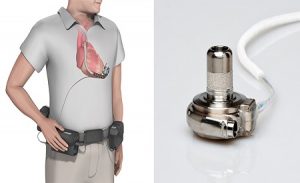
A heart pump device, also known as a left ventricular assist device (LVAD), is a mechanical device that is implanted into the body to help support the function of the heart. It is typically used for people with heart failure, which is a condition where the heart is unable to pump enough blood to meet the body’s needs.
The LVAD is implanted into the chest and connected to the heart, where it helps pump blood from the heart to the rest of the body. The device typically consists of a pump and a battery, and it is powered by a small external battery pack or through a cable that runs through the skin.
The heart pump device is not a cure for heart failure, but it can help improve the quality of life for people with the condition. It can help reduce symptoms of heart failure, such as shortness of breath and fatigue, and it can also help improve the heart’s ability to pump blood. In some cases, the LVAD may be used as a bridge to transplant, allowing a person with heart failure to recover until a heart transplant can be performed.
Heart failure is a debilitating condition that affects millions of people worldwide. In heart failure, the heart is unable to pump enough blood to meet the body’s needs, leading to symptoms such as shortness of breath, fatigue, and an increased risk of heart attack and stroke.
Traditionally, the treatment of heart failure has focused on managing symptoms and improving the heart’s ability to pump blood through the use of medications and lifestyle changes. However, for some people with severe heart failure, these treatments are not enough.
Get Your Sample PDF Here>>> https://www.alliedmarketresearch.com/request-toc-and-sample/5512
What are the types of LVAD machines(Heart Pump Devices)?
- Axial Flow Pumps: These pumps have a simple design and work by drawing blood into the pump, compressing it, and then pushing it out. They are typically smaller in size and less invasive than other types of LVADs.
- Centrifugal Pumps: Centrifugal pumps use a spinning impeller to move blood from the heart to the rest of the body. They are larger in size than axial flow pumps, but they are also more efficient.
- Continuous-Flow LVADs: These pumps are designed to work continuously, providing a constant flow of blood to the body. They are typically more reliable and require less maintenance than pulsatile-flow LVADs.
- Pulsatile-Flow LVADs: Pulsatile-flow LVADs mimic the natural beating of the heart, creating a pulsatile flow of blood. They are typically less reliable and require more maintenance than continuous-flow LVADs.
- Implantable Miniaturized LVADs: These are small, less invasive LVADs that are implanted directly into the heart. They are designed for use in less severe cases of heart failure and are often used as a bridge to transplant.
Each type of LVAD has its own advantages and disadvantages, and the choice of which type of LVAD to use depends on several factors, including the severity of the heart failure, the patient’s age and overall health, and other medical conditions. Your healthcare provider can help you determine the best type of LVAD for your specific needs.
Can you live a normal life with a Heart Pump Devices?
Yes, it is possible to live a relatively normal life with a heart pump, also known as a left ventricular assist device (LVAD). LVADs are designed to help support the heart’s pumping function, allowing people with heart failure to improve their quality of life and reduce symptoms such as shortness of breath and fatigue.
However, living with an LVAD does require some adjustments and lifestyle changes. For example, people with LVADs need to take precautions to avoid infections and other complications, such as wearing gloves when handling the external battery pack and avoiding close contact with people who are sick.
In addition, people with LVADs may need to limit their physical activity and avoid certain activities, such as diving or contact sports, to prevent injury to the device. They will also need to visit their healthcare provider regularly for follow-up appointments and to have their device checked.
Overall, while living with an LVAD requires some lifestyle changes, many people are able to lead relatively normal lives with the help of this device. With the right care and support, people with LVADs can continue to live active, fulfilling lives.
In conclusion, heart pump devices are a major breakthrough in the treatment of heart failure. By providing support to the heart’s pumping function, LVADs can help improve the quality of life for people with heart failure, allowing them to lead more active, fulfilling lives. If you or a loved one is living with heart failure, talk to your healthcare provider about the possibility of receiving a heart pump device.
Contact Us:
David Correa
USA/Canada (Toll Free): +1-800-792-5285, +1-503-894-6022
help@alliedmarketresearch.com

